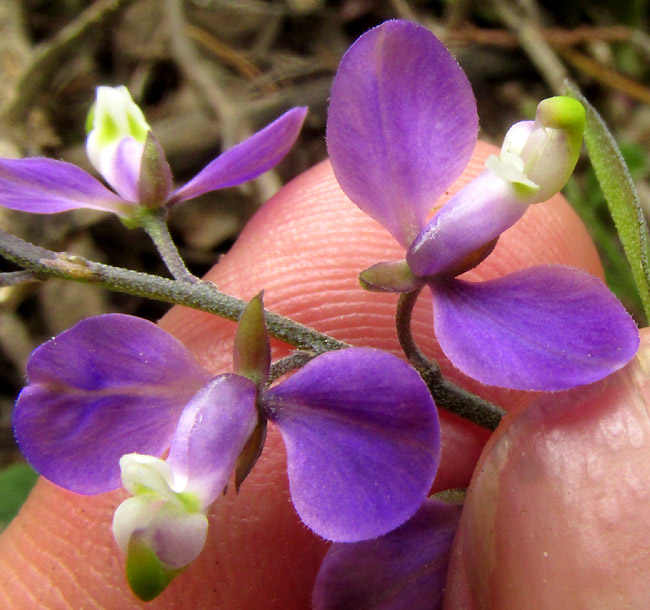Excerpts from Jim Conrad's
Naturalist Newsletter
Entry from field notes dated August 31, 2023, taken in Los Mármoles National Park in the Eastern Sierra Madre mountains, Hidalgo state, MÉXICO, along steeply climbing road heading eastward out of town of Trancas {on maps designated "Morelos (Trancas)"} toward Nicolás Flores; juniper/pine forest on limestone bedrock; elevation ~2,300m (~7,550ft); ~N20.80°, ~W99.25°
POLYGALA COMPACTA

On a usually shaded, very steep, rocky slope in juniper/pine forest degraded by firewood gatherers and roaming cattle, the above wildflower displayed an unusual combination of features. Mainly, its flowers were strongly bilaterally symmetrical with widely spreading wings, like many members in the huge Bean Family, but its leaves were simple with no hints of stipules at petiole bases, which is unlike that family. Here are some blossoms closer up:

In terms of general appearance, these flowers are very suggestive of papilionaceous blossoms of the Bean Family -- for example those of the Oakwoods Prairie Clover. However, the leaves are simple, not compound as in most Bean Family members, plus they lack Bean Family stipules.
This similarity is more apparent than real. The above flowers seem to produce lilac-colored, widely flaring "wings" exactly like wings of Bean Family papilionaceous flowers, but Bean Family wings are side petals of the flower's corolla, while our plant's wings are much expanded calyx lobes, or sepals. At the base of the flower in the above picture's top, left corner you can better see how the calyx's upper sepal is small and sepal-like, but the sepals next to it expand into lilac "petaloid" structures. The rest of the flower didn't look quite right for the Bean Family, either. Here's a closer look at a flower's front part:

In Bean Family papilionaceous flowers the two bottom petals fuse along their common margins to form a scoop-shaped "keel." Above, at the top, right, the curved, greenish item is a genuine keel, but there's no hint of two petals fusing to form it. It's a single, curved-cylindrical petal, the margins of which turn white and spread outward, maybe providing a pollinator landing pad. Also, Bean Family papilionaceous flowers usually display one top petal, called the standard or banner, which often is the most conspicuous of five petals. Our flower has at its top two, not one, white and green petals, which abruptly bend backward. Here's a closer look at the stem and leaves:

These short-hairy, simple leaves with no lobes or teeth, and no hint of stipules at their petiole bases, aren't Bean-Family-like.
Whenever you see a plant at first looking like it belongs to the abundantly occurring Bean Family, but closer examination shows that it isn't, it's a good idea to think "Milkwort Family" -- the Polygalaceae. Milkworts aren't to be confused with the unrelated but better known milkweeds of the Dogbane Family. However, on the Phylogenetic Tree of Life, the big Bean and much smaller Milkwort Families constitute branches very close to one another, having shared a common ancestor not long ago, evolutionarily speaking. They're almost sister families, arising from the same ancestor, but not quite.
In this part of the world the Milkwort Family is represented by only three genera. Since our plant is herbaceous, not woody, and its racemes produce more than three flowers, our plant is recognizable as a true milkwort, genus Polygala. That genus currently comprises 669 accepted species worldwide, of which maybe nine or ten species are documented for our part of upland central Mexico. By the way, the name milkwort derives from the genus name Polygala, which in ancient Greek meant "much milk." The name giver in 1753 believed that cattle grazing on this plant produced more milk.
In our area, if you have a Polygala whose flowers display spreading, lilac-colored wings, the keel tips do not bear clusters of small but conspicuous, fingerlike projections, and the flowers arise from pedicels less than 3.5mm long (0.14inch), you have POLYGALA COMPACTA, with no English name beyong the generic milkwort.
Polygala compacta is endemic just to the Mexican highlands from the northwestern states of Baja California Sur and Durango south through central Mexico to Oaxaca. It's described as occurring in dry scrub and pastured areas on limestone, and our battered juniper/pine forest was close enough to that. It's also said to appear within a fairly limited elevation range, 2250-2600m, so our 2300m is about right.
On the Internet at this time I find no images clearly showing the flowers, though several blurry ones seem to indicate blossoms like ours. There's not much in the literature about this species, other than its appearance on various lists of plants found at specific locations. Flowers on our plant lacking fingery crests on their keels along with their specific color combination neatly set our Polygala compacta apart from other species. On the Internet, numerous plant images are labeled Polygala Compacta, but they are very different ornamental bushes whose name only indicates that they're some kind of Polygala, probably with a very mixed, hybridized heritage, growing in a compact form, unlike our plant.
Interestingly, the 2012 study by M. Angélica Bello and others entitled "Combined phylogenetic analyses reveal interfamilial relationships and patterns of floral evolution in the eudicot order Fabales," found that during the evolution of the Bean and Milkwort Families, the keels of the flowers of the two families may have arisen independently. They look the same because of convergent evolution.